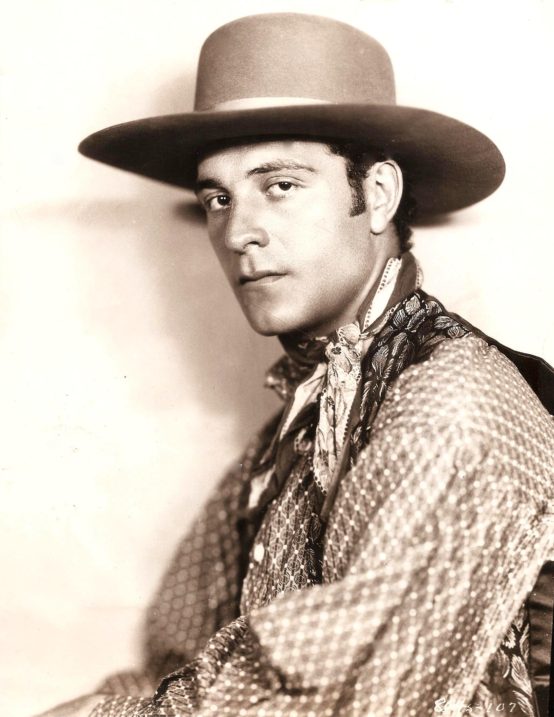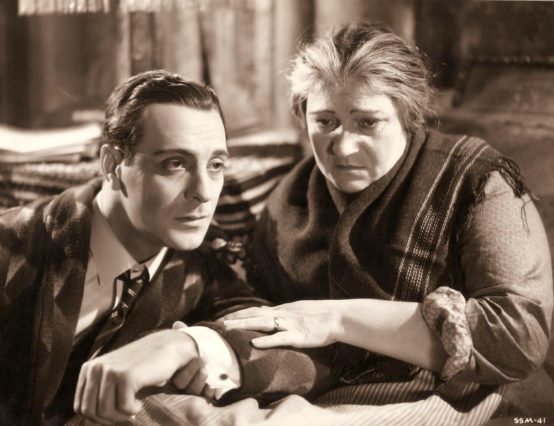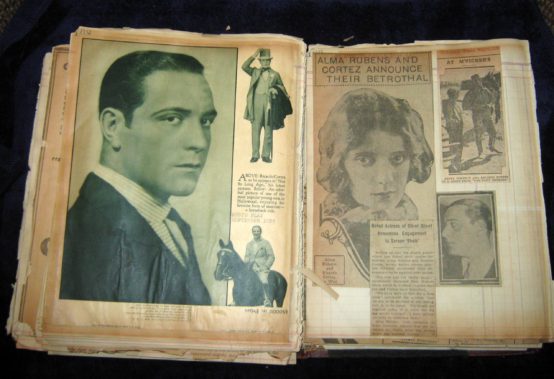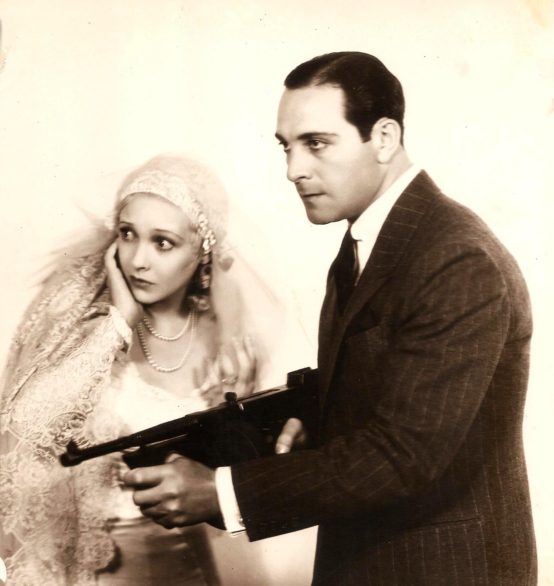Introduction
 Dan Van Neste returns to Immortal Ephemera to talk about his most recent book, The Magnificent Heel: The Life and Films of Ricardo Cortez, published in 2017 by BearManor Media.
Dan Van Neste returns to Immortal Ephemera to talk about his most recent book, The Magnificent Heel: The Life and Films of Ricardo Cortez, published in 2017 by BearManor Media.
You can purchase The Magnificent Heel: The Life and Films of Ricardo Cortez in variety of formats (Hardcover, Paperback, Kindle, Nook, PDF eBook) from all major retailers, the publisher, and even the author himself.
Dan has long been a friend of this site, first stopping by in 2012 to help me understand The Whistler series, a group of movies I’ve come to love since that time. I got to know Dan better over time because every time I’d prepare to post a biography of a film star who I’d felt had been unfairly neglected, I’d discover Dan hadn’t neglected them, and one of his articles in Classic Images or Films of the Golden Age would turn out to be my only modern source. Such was the case with Helen Twelvetrees. Dan Van Neste was kind enough to write the foreword in my own book, Helen Twelvetrees, Perfect Ingenue.
As will be mentioned below, one of Miss Twelvetrees’ frequent leading men was Ricardo Cortez. An interesting star of silent and Golden Age movies, Cortez is one of those old-time actors who just grows on you every time you luck into seeing him in something you hadn’t seen before. I prefer the slippery “Magnificent Heel” of Dan’s title, the smarmy, toothy Cortez who played the villain in early talkie titles opposite Twelvetrees like Her Man (1930) and Bad Company (1931), though he’s also great as Sam Spade in the first version of The Maltese Falcon (1931), and, especially since I’ve learned more about his background, Cortez has grown on me as the Jewish doctor in Symphony of Six Million (1932).
But there’s so much more to Ricardo Cortez. Jacob Krantz? Alma Rubens? Sam Spade? Billed over Garbo? Garbo! Dan Van Neste touches upon all of that and more in the interview that follows.

Cortez always claimed he never kept scrapbooks, but he was in possession of at least three at the time of his death in 1977. Each one was devoted to a different stage of his career. The largest by far, was this one, devoted to his silent films.
Questions About Ricardo Cortez
Q: Dan, you’ve written about so many of my favorite stars in shorter-length articles, what was it about Ricardo Cortez that drew you to him as a subject for a full-length book?
Dan Van Neste: It seems I’ve always been intrigued by Ric Cortez. Whether playing a hero or a villain in the movies, to me, Cortez consistently stood out. I always thought he was a good, versatile actor who never became a superstar, but could hold his own even when paired opposite the greatest star actors in the motion picture business. It fascinated and always impressed me he was able to make a successful transition from silent to sound movies when so many of his contemporaries were not.

People are often surprised to learn Cortez played almost as many heroes in his long career as villains. One of his best early heroic roles was as a gambler turned Pony Express rider in James Cruze’s big budget western, THE PONY EXPRESS (Paramount-1925).
I also had other, more general reasons for selecting someone like Ricardo Cortez as a subject. From the time I began writing about classic films in the late 1980’s, I’ve had two main goals in mind: # 1) to do original work; #2) to write about lesser known, yet worthy filmmakers whose stories had never been told. Early on, I compiled a list of possible subjects for my writing projects that met those criteria. As fate would have it, I have been able to write articles on many of those individuals through the years. Cortez’s name was on that original list, but for one reason or another, I never got around to him.
When I began writing books in the mid 2000’s, I still had the list. After finishing my volume on the Whistler series in 2011, I thought it was a good time to tackle a project which was even more challenging: a full length biography on someone. But who? I had six or seven possibilities in mind, but couldn’t decide. I finally opted to consult a few writer friends. I listed the names, and asked them which of these individuals they would rather read about. Cortez was the overwhelming, almost unanimous selection. My difficult decision was made for me. Kudos to my friends for an inspired choice.

Cortez had a very showy role a young penniless writer who makes a pact with the devil (Adolphe Menjou) in D.W. Griffith’s lavish drama, THE SORROWS OF SATAN (Paramount- 1927).
Q: Your Ricardo Cortez book is split in two: A biography portion and a section covering all of Cortez films. I did something similar with Helen Twelvetrees in order to draw more attention to her largely forgotten filmography without clogging the biographical section of my book with a multitude of film factoids. Did you approach Cortez in this manner for similar reasons?
Dan Van Neste: Like your informative, well researched and well crafted volume, Helen Twelvetrees, Perfect Ingenue, the Cortez book is really two books in one: a biography and a lengthy filmography. I structured The Magnificent Heel in this way for both stylistic and functional reasons.
I’ve always believed if a writer is going to pen a biography on a filmmaker, they not only need to tell the individual’s personal story, but also discuss their work in detail. To me, their work is their true legacy, the reason people want to read about them in the first place. Ricardo Cortez had a substantial filmography (100+ movies), and it would have been a terrible oversight not to discuss his films specifically. A separate film section gives his work an added emphasis. It is also helpful in other ways.

Cortez won a long term contract with RKO-Pathe Pictures, thus reestablishing his career as a motion picture actor, as a result of his acclaimed performance as a brutal pimp in director, Tay Garnett’s hit melodrama, HER MAN (1930), costarring Helen Twelvetrees. (the first of three popular movies pairing the duo).
As a connoisseur of biographical books myself, I tend to get very impatient with those that get bogged down discussing the plots of movies. It is necessary to a degree, but can easily get out of hand. The last thing a writer wants to do is bore his readers. Having a special section in a book for essential details such as casts, crews, plot summaries, reviews, etc. allows the author to provide this critical information without descending into the “weeds.” In reference to this particular book, the filmography section also proved very valuable as a repository for fascinating backstory details of Cortez’s motion pictures I found while doing research in various libraries, and studio and newspaper archives. I placed this type of material in a special trivia/interesting facts subsection (under each movie heading.)
Q: Cortez and Twelvetrees co-starred in three entertaining features: Her Man (1930), Bad Company (1931), and Is My Face Red? (1932)? Which was your favorite?
Dan Van Neste: Let me begin by saying I thought Cortez and Twelvetrees made a very engaging pair! They seemed to play off one another beautifully. I agree with you. All three of their movies together were exceedingly entertaining, sometimes riveting motion pictures. All three were hits, and among the highlights of Cortez’s career. Although he worked with most of the great, acclaimed feminine stars of the late silent and early sound eras — names like Swanson, Garbo, Stanwyck, Davis, Colbert, Crawford, Lombard, etc.), Ric Cortez admired Helen Twelvetrees, and enjoyed working with her.
I liked all three movies, and it’s impossible not be fascinated by Goldie Gorio, the charismatically crazy gangster Cortez portrayed in Bad Company, but you may be surprised to learn my favorite is Is My Face Red?
To me, the role of the amoral gossip columnist, William Poster gave Cortez one of the best, most multi-faceted parts he was ever assigned, one which allowed him an opportunity to play both dramatic and comic scenes which he handled very skillfully. Given the rave reviews he garnered for Is My Face Red?, it is disappointing and somewhat surprising Cortez was so rarely given an opportunity to do similar type material, particularly comic parts.

As the amoral gossip columnist, William Poster, in the comic melodrama, IS MY FACE RED? (RKO-1932), Cortez won some of the best reviews of his career.
Q: Continuing on the subject of the actual films, which are your favorite Ricardo Cortez titles? Any hidden gems? And more generally, which two or three would you recommend to turn someone else into a Cortez fan?
Dan Van Neste: Gosh, I have many personal favorites! I mentioned one of them, Is My Face Red? I separate my Cortez favorites into three categories according to the type of role he played: heroes, villains, and combinations of the two.
Many are amazed to learn Ricardo Cortez played almost as many heroes in motion pictures as heels or criminals. My favorite heroic roles would include the tough gambler who takes on a corrupt politician in order to foil a diabolical plot against the United States in The Pony Express (1925), the kindly businessman who assists a struggling taxi dancer in Ten Cents a Dance (1931), the morally conflicted surgeon in Symphony of Six Million (1932), and the defense attorney who represents his wife’s lover accused of murder in Hat, Coat, and Glove (1934).

At the peak of his popularity in 1932, Ric Cortez was cast as a morally conflicted Jewish surgeon in director Gregory La Cava’s big budget drama, SYMPHONY OF SIX MILLION (RKO), costarring Irene Dunne, Gregory Ratoff, and theatre actress, Anna Appel (pictured here).
Among my favorite Cortez villains were the knife-wielding pimp in Her Man (1930), the mentally deranged gangster in Bad Company (1931), the hard-hearted scoundrel who exploits a kindly wrestler in Flesh (1932), the small-time crook who takes advantage of an innocent young girl and transforms her into a tough gangster moll in Midnight Mary (1933), the gun runner who sells his girlfriend into white slavery in Mandalay (1934), the two timing dancer in Wonder Bar (1934), and the Capone-like, tax evading mobster in Special Agent (1935).
In my opinion, Cortez’s very best roles were fascinating combinations of heroes and heels. They include the poor writer who becomes a pawn of the devil in The Sorrows of Satan (1926), the ruthless, womanizing private detective Sam Spade in the first screen adaptation of Dashiell Hammett’s classic novel, The Maltese Falcon (1931), the crooked cardsharp who helps a parolee get back on her feet again in The House on 56th Street (1933), and the corrupt professional gambler who tries to go straight in Her Husband Lies (1937).

Cortez signed a long term contract with Warner Brothers in the summer of 1933. Among his first assignments was the role of a two-timing dancer in the studio’s Grade A all-star musical, WONDER BAR (1934). Here he is seen holding hands with costar Dolores Del Rio in between takes of their dance scenes.
You asked about hidden gems. I would say most of the above would qualify, because they are largely unknown to the public except perhaps to the most devout classic film enthusiasts. In fact, I believe one of the main reasons Cortez has become a rather obscure figure in motion picture history today, is because he never made a movie widely recognized a great classic motion picture — one that is considered important enough to be continually screened. Many of the aforementioned motion pictures are very good and do show up on TCM, etc., but only occasionally.
To get a good feel for Cortez’s overall work, I would definitely recommend seeing one or two of his silent films such as The Pony Express, Torrent (1926 with Garbo) or D. W. Griffith’s The Sorrows of Satan (1926), three or four of his early sound pictures like The Maltese Falcon, Symphony of Six Million, Is My Face Red?, The House on 56th Street, and one or two of his late 1930’s or 1940’s titles like Her Husband Lies, Mr. Moto’s Last Warning (1939), World Premiere (1941 with John Barrymore) and the famed noir classic, The Locket (1946).

Cortez transitioned to characters roles later in his career. Here he is with Robert Mitchum and Laraine Day in the melodrama, THE LOCKET (RKO-1946).
Q: Do you prefer silent Cortez or talkie Cortez? And which half of his career do you believe should be considered more important when considering Cortez as a whole?
Dan Van Neste: Interesting question! In my opinion, Cortez was a very skillful actor and a prominent star in both silent and early sound films. He was particularly adept at acting with his eyes, the proverbial “windows to the soul.” He learned the art of acting from the best silent and sound films teachers – by working with many of the greatest directors, skilled craftsmen, and actors of his day.
Based on my research (which included viewing approximately two thirds of his feature films), at this time, I would say, I prefer his sound film performances, and believe they constitute his greatest claim to fame. But, having said that, I do reserve the right to change my mind. Let me explain.
 Cortez made 37 silent feature films between 1922-1930, and only 17 are known to have survived. Of those, only 14 have survived intact with all their original footage, and the majority of the survivors are stored in archives, thus are not readily available to the general public and to many researchers. Only six are available on DVD. I was able to see eight of Cortez’s silent titles prior to writing the book, enough to know he was a very good silent film actor, but not enough to say categorically, he was better in silents than in sound films.
Cortez made 37 silent feature films between 1922-1930, and only 17 are known to have survived. Of those, only 14 have survived intact with all their original footage, and the majority of the survivors are stored in archives, thus are not readily available to the general public and to many researchers. Only six are available on DVD. I was able to see eight of Cortez’s silent titles prior to writing the book, enough to know he was a very good silent film actor, but not enough to say categorically, he was better in silents than in sound films.
Q: Cortez is one of those interesting film stars who was eventually able to successfully transition from silent films to talkies. I say eventually, because it was especially bumpy road in Cortez’s case. What would you say was harder for Ricardo Cortez, making the transition from one form of film to the other, or overcoming the negative publicity that he endured during the same period due to the death of his wife, Alma Rubens?
Dan Van Neste: Both were tremendously difficult, and occurred simultaneously, making them even more overwhelming and problematic. Cortez was forced to do a stint on vaudeville in 1930, to prove to film producers and movie executives he had the vocal chops and ability to make it in the new sound era. Doing live stage shows was tremendously scary and challenging to the introverted, fan phobic Cortez who was used to performing in front of a camera before a small audience consisting of the director, fellow actors, a few craftsmen and crew members.

— In order to prove to film producers and executives he had the acting and vocal ability to make it in the new sound era, in 1930, Cortez signed a pact with the Radio-Keith-Orpheum company to appear in live stage shows all along the East coast. His performances of the Edwin Burke penned playlet, “Wanted,” were enormous successes with the public. This is a page from a scrapbook the company presented to Cortez after the tour, containing clippings and notices from his appearances.
In my opinion, however, the psychological trauma, and negative publicity associated with Alma Rubens’ losing battle with morphine addiction was even more difficult — undoubtedly one of the most challenging things Cortez ever faced.
It affected him personally, and had a profound impact on his professional career. For a very private, controlling individual like Ricardo Cortez, it must have been so heartrending, and exceedingly frustrating to have your wife (who you cared about) self-destructing before your eyes and in public view, and be powerless to do anything about it. From late fall, 1928, until her untimely death in 1931, Alma was almost constantly generating negative headlines which not only reflected on her, but on her famous husband.

A couple of the pages from Ricardo’s very fragile, 90+ year old silent film scrapbook. These are from 1925, at the time Cortez announced his engagement to twice married actress, Alma Rubens.
Although it’s not part of the question, if you and your readers don’t mind, I would like to say something about the book.
The Magnificent Heel is an unvarnished “warts and all” look back at the life and career of a very complicated guy who exhibited many strengths and weaknesses in his long life. Like most human beings, Ricardo Cortez didn’t always do the right thing, or react to specific situations properly. As his biographer, I felt I had a responsibility to present him as he really was – both the positives and negatives. To me, to do otherwise, would have been a disservice to the readers and to him.
Having said that, I sincerely hope people who read the volume, will see him in a positive light. One of the things I personally admired most about Ricardo was his courage and fortitude. He went through some very dark, trying times, but met each of life’s daunting challenges head on, forging ahead aided by a combination of talent, intelligence, determination, and lots of hard work.
 Q: Which Cortez fact do you most like to trot out when explaining to someone the fascination with your subject? There seem to be some major themes that I came to the book wanting to know more about and that you managed to answer, ie: Ricardo’s background as Jacob Krantz; his marriage to Alma Rubens; his personal and professional relationship with his now better known brother, cinematographer, Stanley; and Ricardo’s post-Hollywood life and career.
Q: Which Cortez fact do you most like to trot out when explaining to someone the fascination with your subject? There seem to be some major themes that I came to the book wanting to know more about and that you managed to answer, ie: Ricardo’s background as Jacob Krantz; his marriage to Alma Rubens; his personal and professional relationship with his now better known brother, cinematographer, Stanley; and Ricardo’s post-Hollywood life and career.
Dan Van Neste: I like to trot out multiple facts whenever I take part in any type of discussion or interview regarding Cortez and the book. I would separate the facts into two categories — those I knew prior to my research, and those I learned as a result of it.
In addition to my general admiration for Cortez’s skill described previously, there were other facts which made him an attractive subject to me as I embarked on the project. For instance, he was the only American film actor to be first billed over the legendary Greta Garbo, the first to play author Dashiell Hammett’s famed Sam Spade in the movies, a popular movie star for over five decades with over 100 feature films on his resume. In addition, he was a prominent star of the late silent and early sound eras and worked with many of the greatest filmmakers of the day. Although highly regarded as a very professional and versatile actor, he won particular recognition for playing charismatic rascals and villains.

Undoubtedly, Cortez’s most famous role was as private detective Sam Spade, in the first film adaption of Dashiell Hammett’s famous novel, THE MALTESE FALCON (Warner Bros. 1931) costarring Bebe Daniels.
Since so little had been written about Cortez through the years, early on, I realized I had my work cut out for me if I were going to tell the story of his life and career. Most previous write-ups on Cortez were exceedingly brief, error riddled summaries. No real details about his personality and personal life, or analyses of his work were provided.
Needless to say, I had scores of questions which I felt must be answered if this biography were to succeed. I organized them into three broad categories which I set forth in the introduction: #1) Who was Ricardo Cortez? (both professionally and personally); #2) Why has he been forgotten?; #3) What is his true legacy?
Answering those key questions was my primary focus and took me in all kinds of directions, exploring his various life events, personal and professional relationships. To me, the success or failure of this biography is based on how well I was able to answer those questions, while at the same time, making Ric’s personal story interesting and entertaining to read.
I learned so many fascinating facts and important pieces of personal and profession information about Cortez and those around him, as a result of the four years I spent researching and writing, The Magnificent Heel. I tried to share as much of the material as I could in the book.

This cover from the trade magazine, Hollywood Reporter dated August 31, 1932, features an article about Cortez’s departure from RKO. The entire issue was found in his sound film scrapbook. Note the address on the top.
It’s impossible to predict what others will find interesting in any piece of work, but speaking for myself, I think there were a few especially interesting details and stories that stood out. Among them were: the sad, often inspiring chronicle of Cortez’s early life and initial years in Hollywood, the story of his complicated, doomed relationship with his first wife, Alma, accounts of his East Coast vaudeville tour, and the reestablishment of his film career during the early 1930’s.
Also especially intriguing to me, were behind-the-scenes details I learned regarding the productions of some important Cortez films like: The Pony Express, Torrent, The Maltese Falcon, Wonder Bar, and The Last Hurrah, his flirtation with directing, his success as an investor, later as a stockbroker, and his interest in men’s fitness and attire.

After two failed unions, Cortez married for the third and final time in 1950. His bride was an attractive former secretary named Margarette Belle who was almost 20 years his junior. The marriage would be a long, and happy one lasting until Mr. Cortez’s death in 1977. Both Ric and Margarette loved to travel. This candid photo from 1964, taken aboard the ship, Queen Elizabeth, features Mr. and Mrs. Cortez on one of their many trips. It was in Margarette’s personal collection.
Lastly, to me, one of most important things contained in the book are vital facts. Thanks to an examination of birth and death certificates, census data, and other family records, we now know once and for all, Cortez’s correct birthplace, birthdate, and cause of death, as well as heretofore unknown information regarding his family and his post Hollywood years.
Cliff: Thank you very much, Dan! The book has been out awhile now, and the reviews are in, but just let me echo the consensus: fantastic job, a wonderful biography of a tough subject who I really appreciated having the opportunity to learn more about thanks to your magnificent work.
About Dan Van Neste
A native of Michigan, author, biographer, film historian Dan Van Neste has penned over 50 major movie related articles for various newspapers, magazines, and film journals during the past two decades. Best known for his star profiles in Classic Images and Films of the Golden Age magazines, his work has merited eight cover stories. Many of his articles have included original interviews with vintage filmmakers.
His first book, The Whistler: Stepping Into the Shadows was a salute to the influential, groundbreaking suspense film series produced by Columbia Pictures (1944-48). Dan and I discussed the Whistler series in a previous interview. You can pick up your copy of The Whistler: Stepping Into the Shadows on Amazon.com HERE.
The Magnificent Heel: The Life and Films of Ricardo Cortez is Dan’s second book, published in 2017 by BearManor Media. You can purchase it in variety of formats (Hardcover, Paperback, Kindle, Nook, PDF eBook) from all major retailers, the publisher, and even the author himself.
In addition to his personal website, Dan Van Neste is also co-admin of the Facebook group Ricardo Cortez (1900-1977).




Leave a Reply